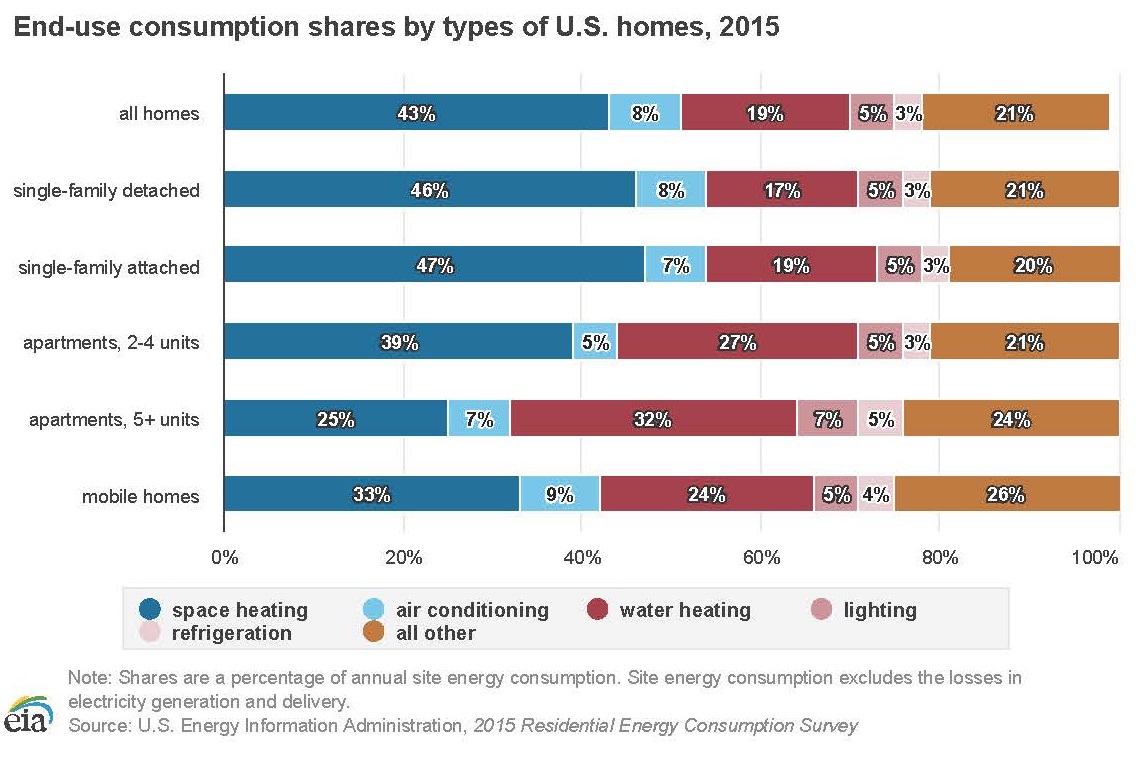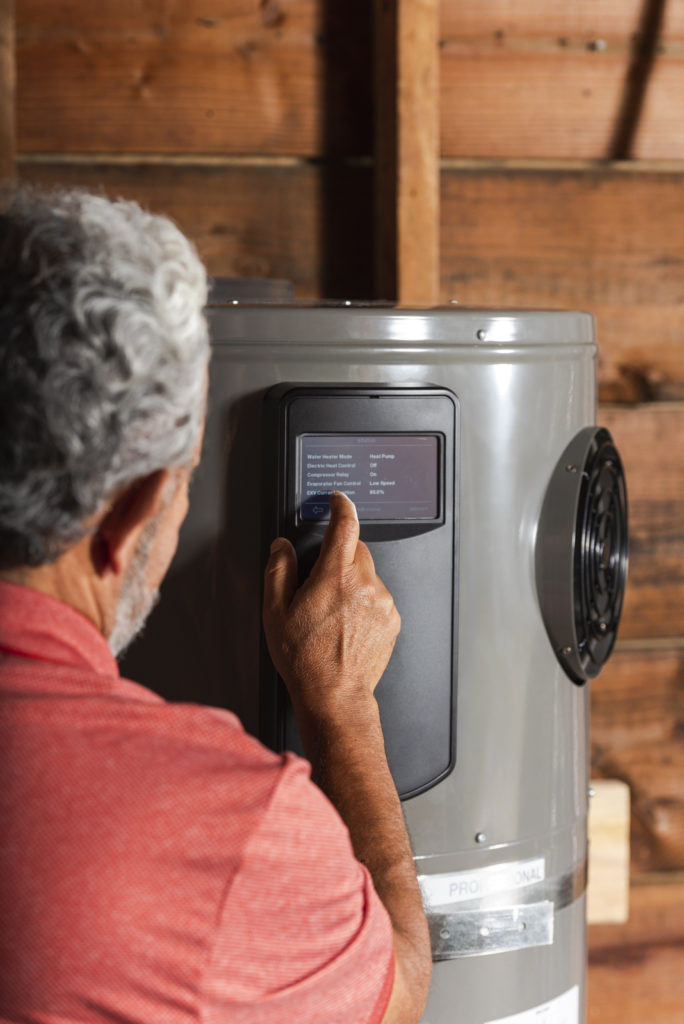While the average person might not think about it when turning on the faucet, changing the way you heat water in your home or business could drastically reduce your carbon footprint. Water heating accounts for a large share of the energy use of buildings—up to 17% in single-family and 32% in multifamily homes. With buildings currently representing 39% of U.S. carbon emissions, momentum is growing for energy-efficient technologies such as heat pump water heaters (HPWHs), which are two to four times more efficient than most conventional approaches to water heating. HPWHs are attractive because they not only reduce energy use and carbon emissions; they can also store hot water for later use, shifting energy demand to times when the carbon impacts of energy production on the electric grid are lower. This will become even more important to utilities and grid managers as we shift to a 100% renewable energy grid that needs more flexible load management.
 HPWHs currently represent only 2.2% of the U.S. water heating market, and less than half of those are grid-connected, according to a 2018 RMI report. Considering that all water heaters currently in use will likely need to be replaced by 2035 (based on the current lifespan of conventional technologies), there is no time to lose in shifting the market toward cleaner, more energy-efficient HPWHs. In doing so, U.S. households would save nearly 100 million tons of carbon emissions every year.
HPWHs currently represent only 2.2% of the U.S. water heating market, and less than half of those are grid-connected, according to a 2018 RMI report. Considering that all water heaters currently in use will likely need to be replaced by 2035 (based on the current lifespan of conventional technologies), there is no time to lose in shifting the market toward cleaner, more energy-efficient HPWHs. In doing so, U.S. households would save nearly 100 million tons of carbon emissions every year.
The Advanced Water Heating Initiative (AWHI), which started as a successful West Coast initiative, is evolving into a national effort with a goal to make high efficiency, grid-connected HPWHs the primary choice for all heating water in residential and commercial buildings throughout the United States. In April 2021, the collaborative of AWHI participants, NBI along with our key partners (BPA, NEEA, SMUD) and critical support from the U.S. Department of Energy (DOE) and ENERGY STAR, launched AWHI as a national program. Its goal: 100% market share for residential water heating by 2030 and 90% of the multifamily new construction market for central HPWH by 2026. Reaching AWHI’s moonshot goals can bring many benefits—including less pollution from fossil fuel combustion appliances, lowered climate risks, and workforce development opportunities with higher wage job creation for installers and other workers along the supply chain.
“With the number of wildfires and serious storms growing every year, we cannot afford to wait,” said California Energy Commissioner Andrew McAllister. “AWHI lands at a critical juncture of our climate change and economic recovery challenges. Not only can we help decarbonize buildings with heat pump water heaters, but we will also help develop a U.S. workforce to manufacture and install these products, creating good paying jobs to get it done.”

A national effort with regional partners
AWHI is seeking to seed several regional efforts that tailor to regional needs. The West Coast market has been catalyzed by AWHI collaborations in California, largely through state-funded programs and programs offered by the Sacramento Municipal Utility District (SMUD). Northwest Energy Efficiency Alliance (NEEA) and Bonneville Power Administration (BPA) continue to make progress in the Northwest, helping HPWHs gain market share. In the Midwest, AWHI recently launched a new initiative in partnership with the Midwest Building Decarbonization Coalition, which is engaging community partners to help ensure equitable access to HPWHs. AWHI is also working with NYSERDA and Northwest Energy Efficiency Partnerships (NEEP) to explore Northeast implementation of HPWH efficiency programs, and are seeking anchor partners in the Southeast.
Working groups make progress on market barriers
All of AWHI working groups are now scaling up to focus on challenges at the national level. With advice from a national steering committee of industry, government, utility, researchers and other stakeholders, these working groups are addressing the most significant barriers to widespread market adoption of HPWHs in the residential and commercial markets—both unitary and central systems. Priority market barriers being addressed include bringing down the cost of equipment, building awareness of and confidence in products, and growing the availability of products for purchase and installations.
Looking ahead, the working groups will focus on the following strategies:
- Target new construction for rapid increase in market share. The new construction market is the most ripe to deploy HPWHs—both for residential unitary systems through engagement with homebuilders, and the multifamily new construction market for central HPWHs. AWHI will also work to ensure product availability in targeted markets and that trained installers are available.
- Focus on replacements through increasing installer confidence and awareness. Installer education for new construction will spill over to replacements. About 85% of water heaters are replaced in an emergency situation, which means installers must have products readily available on their trucks. Replacement of electric resistance products with the 240-volt unitary systems is especially low hanging fruit, since no electrical upgrade is required.
- Ensuring better consistency in programs. HPWHs have higher upfront costs compared to conventional hot water heaters, which means that incentives and tax or rate subsidies can ease first-cost resistance. Making sure installers know about ways to cut product expenses encourages homeowners, especially lower income owners with a higher energy burden, to choose heat pump technology. The residential working group is creating incentive program design guidelines to create consistency in local markets and align with the installer process.
- Build awareness to accelerate consumer demand. Building owners need better education about product viability, available incentives, and the benefits of swapping out for energy-efficient, low-emissions appliances—including a smaller carbon footprint and less air pollution. AWHI is working with partners such as utilities, manufacturers, and installers to develop and share key marketing messages. For example, EPA recently released ENERGY STAR Home Upgrade, a set of six high-impact, energy efficiency improvements for home use, that features ENERGY STAR certified HPWHs. ENERGY STAR will promote these HPWHs and utilize this effort to support water heater promotions. The recommendations and strategies for building market demand are highlighted in two new reports: “Building Demand for HPWHs” and “Increasing Sustainability of Multifamily Buildings with HPWHs.”
- Workforce development through tools and training. While consumer awareness is important to drive demand, it is equally necessary to train industry market actors to be able to support and help fulfill the demand. There is a focus within AWHI to develop training and tools to support both contractors and designers. For example, commercial working group member, Ecotope, launched Ecosizer—a free, educational tool to help designers determine the right sizing of commercial HPWH systems. Several hours of training material and videos have also been developed and more planned to support the central systems.
- Pursue critical policies that enable scaling HPWH installations. As we start 2022, the policy working group is preparing to kick off with a focus on all aspects of codes and policy that impact adoption of HPWH. This will include attention to local, state, and federal codes and policy for building and appliance standards related to efficiency and grid connectivity, and also the regulations around emission standards by air quality districts.
Technological advancements expected to hit the market in 2022
Some technological advancements are critical to widespread adoption of AWHIs. For example, HPWHs run on 240-volt current, which often requires homeowners to spend money upgrading their electrical panel to make the switch from gas-fired water heaters. To address this, the residential 120-volt working group is deploying its “retrofit ready” HPWH specification that can easily plug into an existing 120-volt electrical outlet. Four major water heater manufacturers are developing HPWHs that will run on a 120-volt circuit, meeting this specification. This could make HPWHs a much more attractive option to a larger number of homeowners.

Additionally, central HPHWs manufacturers are assembling a packaged HPWH system that will be skid mounted, which would eliminate custom engineering and onsite construction. This fully plug-and-play system represents a transition of the industry from selling HPWHs to selling water heating systems. This approach reduces overall costs by simplifying and standardizing installations, reduces errors with commissioning, and results in significantly improved performance from the older systems it replaced.
Gaining momentum as we look toward 2022
There has never been a more important time to work collaboratively to reduce carbon emissions in the building sector and help mitigate the most serious climate impacts.
“With the number of wildfires and serious storms growing every year, we cannot afford to wait,” said California Energy Commissioner Andrew McAllister. “AWHI lands at a critical juncture of our climate change and economic recovery challenges. Not only can we help decarbonize buildings with heat pump water heaters, but we will also help develop a U.S. workforce to manufacture and install these products, creating good paying jobs to get it done.”
It will take a community of utilities, industry associations, regulators, cities, program administrators, multifamily building owners, and homeowners to move the needle on the HPWH market. Whether you are a potential regional partner or an individual or company that wants to help AWHI reach our moonshot goal of 100% market share of the residential water heating market, become an AWHI a partner by signing up at www.advancedwaterheatinginitiative.org or emailing questions to [email protected].
by Smita Gupta, Director for Building Innovation, New Buildings Institute
Did you enjoy this content? Consider supporting NBI’s work with a donation today.
